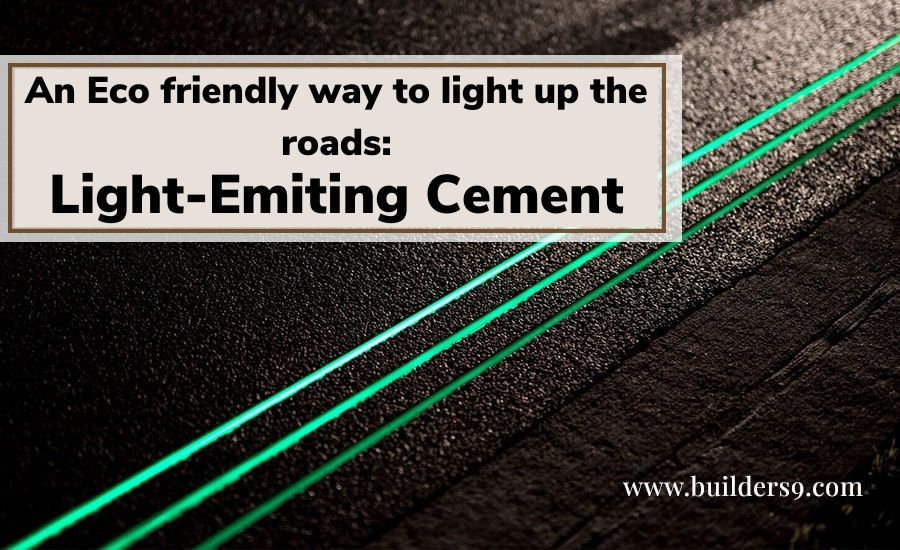Can you foresee your walls lighting up the space without needing any electricity? Have you ever considered how easy it is to drive and stroll on the roads in the middle of the night when there are no streetlights? It’s time to trust that construction technology has advanced in ways you never dreamed of. Light-emitting cement is a unique innovation and energy-efficient construction material that can produce light without the use of any energy sources, thereby saving money and the environment.
Light-Emitting Cement
It can serve as a light source for gloomy walkways without causing light pollution that bothers both wildlife and humans. Light-emitting cement is also charged by natural light from the sun, similar to solar-powered lights found in gardens.
Phosphorescent concrete may illuminate the path home.
Consider a future in which, as dusk gives way to night on a lengthy trip, the darkening highway begins to shine in soft blue and green colors to brighten the path ahead. After the development of light-emitting cement, such potential could become a reality. Without the need for electricity, the innovative material might create lighting routes for automobiles, trucks, bikes, and people.
What distinguishes it from conventional cement?
Light-emitting cement material’s raw components include silica, river sand, industrial waste, alkali, and water. This process, which comprises the polycondensation of raw materials and does not require a lot of energy, can be done at room temperature. The chemical interaction between cement dust and water results in a strong and resistant gel-like material with some unwanted crystal flakes.
Countries using Concrete
Most developed countries today rely on extensive road networks to provide speedy mobility between cities. The United States highway system is made up of about 160,000 miles of road that run across the country, and the majority of these routes require some form of lighting for nighttime vehicles. Lighting for buildings and public use alone consumes 262 billion kilowatt-hours (kWh) each year in the United States, accounting for approximately 19% of total commercial electricity consumption. China’s highway network will be equivalent in size by 2030, demanding similar lighting requirements.
Finding a low-carbon and energy-efficient solution to light highways might drastically reduce energy use as the approaching shadow of climate change forces civilization to shift toward renewable energy. Simultaneously, worldwide cement output is approaching 4 billion tons; energy-efficient highway lighting opens up a massive commercial market that will reward entrepreneurs with new and valuable technology.
A Phosphorescent Roadway
Jose Carlos Rubio of the University of San Nicolas Hidalgo in Mexico identified the need for energy-efficient road lighting nine years ago. His answer was to develop cement that collects and emits solar energy during the day. In essence, his ambition was to create a road and lighting system out of a single material. “When I first started the project, I realized there was nothing like it elsewhere in the world,” Rubio says. “The key issue was that cement is an opaque substance that prevents light from passing through to its core.”
Cement is usually made from dust that is combined with water to form a material similar to hair gel. This gel finally hardens within the mix of materials required to construct today’s hundreds of thousands of miles of concrete roads. This process, however, produces crystal flakes in the gel, which obstruct incoming sunlight.
This helps you save money on electricity. It can be used to illuminate walkways, swimming pools, interior spaces, and highways, among other things.
Light-emitting cement serves as a light source in locations where power is scarce, such as roadways in the forest or in rural areas where power is unavailable. This material can be used in structures, particularly bathrooms and garden walkways.
Light-emitting cement is now available in two colors: blue and green, with the intensity of the light adjustable throughout the manufacturing process.
However, concrete manufactured with this cement is unlikely to light up a highway near you very soon. Even though basic research has shown considerable potential, the next step will be to transfer technologies to commercialization and large-scale manufacturing. However, because of this material’s enormous environmental benefits, future highways could be dazzling beacons of technical innovation in an age searching for energy solutions.
Light-emitting cement is also eco-friendly because the gel is made of sand, dust, clay, and water. Because of the inorganic nature of the cement components, the material has an expected life period of 100 years. This unique substance is sun-resistant and more lasting than conventional phosphorescent materials, such as plastics or paints, which degrade with UV rays over time.
These types of developments are driving construction industry trends and elevating technologies to new heights.

